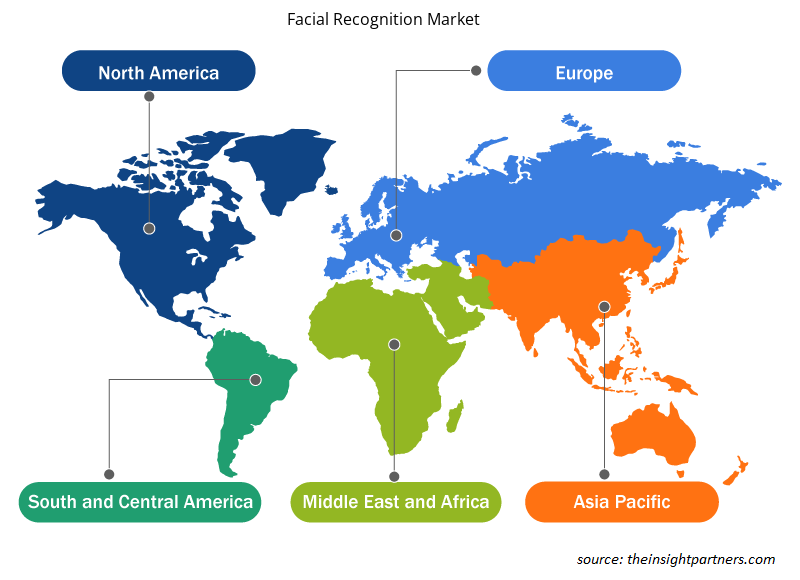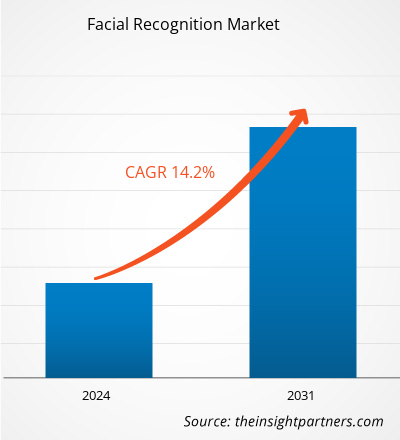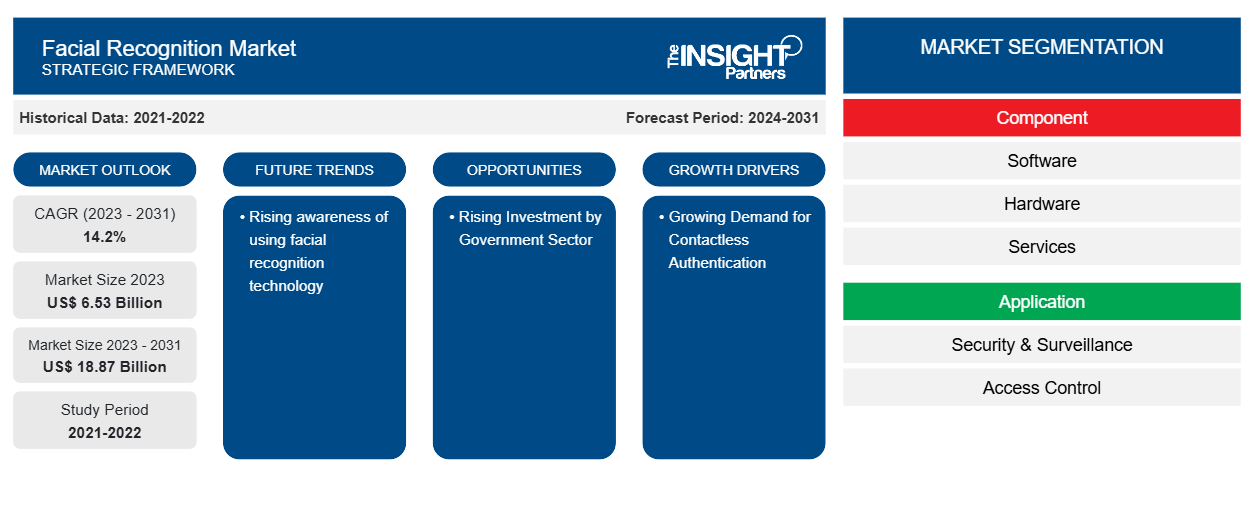Se proyecta que el tamaño del mercado de reconocimiento facial alcance los 18.870 millones de dólares estadounidenses en 2031, frente a los 6.530 millones de dólares estadounidenses en 2023. Se espera que el mercado registre una CAGR del 14,2 % durante el período 2023-2031.Es probable que la creciente conciencia sobre el uso de la tecnología de reconocimiento facial siga siendo una tendencia clave en el mercado.
Análisis del mercado de reconocimiento facial
La creciente demanda de sistemas de videovigilancia eficaces está impulsando la demanda de tecnologías de reconocimiento facial. La tecnología de reconocimiento facial está siendo adoptada por sectores como la seguridad y la aplicación de la ley, la atención sanitaria, el comercio minorista y el transporte para mejorar la seguridad.
Descripción general del mercado de reconocimiento facial
El reconocimiento facial es un tipo de software biométrico que utiliza los rasgos faciales de una persona para verificar su identificación. El reconocimiento facial es un método típico utilizado en sistemas de seguridad para identificar a personas o usuarios específicos. Una de las aplicaciones más frecuentes del reconocimiento facial es desbloquear teléfonos celulares. La técnica también se utiliza en la aplicación de la ley por parte de la policía, la vigilancia por video y el control de pasajeros. El reconocimiento facial mapea matemáticamente las características faciales de una persona y almacena los resultados como una huella facial. Para validar la identificación de un individuo, el programa compara un video o una imagen digital distintos con una base de datos de huellas faciales almacenadas utilizando técnicas de aprendizaje profundo.
Personalice este informe según sus necesidades
Obtendrá personalización en cualquier informe, sin cargo, incluidas partes de este informe o análisis a nivel de país, paquete de datos de Excel, así como también grandes ofertas y descuentos para empresas emergentes y universidades.
-
Obtenga las principales tendencias clave del mercado de este informe.Esta muestra GRATUITA incluirá análisis de datos, desde tendencias del mercado hasta estimaciones y pronósticos.
Factores impulsores y oportunidades del mercado del reconocimiento facial
La creciente demanda de autenticación sin contacto favorecerá al mercado
La creciente necesidad de técnicas de autenticación sin contacto, junto con la disponibilidad de cámaras de alta resolución y el uso cada vez mayor de teléfonos inteligentes equipados con capacidades de reconocimiento facial, está impulsando la industria del reconocimiento facial. Esta tecnología tiene usos en una variedad de industrias, incluidas la vigilancia, la banca, los aeropuertos y el control de acceso . Se estima que el mercado generará grandes ingresos y seguirá creciendo en los próximos años.
Aumento de la inversión por sector público
El segmento gubernamental está compuesto por diversas instalaciones gubernamentales, instalaciones de defensa, municipios, estaciones de servicios públicos y otros. Debido al creciente énfasis en la seguridad nacional, los gobiernos de todo el mundo están invirtiendo significativamente en soluciones de seguridad avanzadas , como los sistemas de reconocimiento facial. Además, el creciente énfasis en el desarrollo de ciudades inteligentes es uno de los otros factores que contribuyen a la adopción de sistemas de reconocimiento facial para aplicaciones de seguridad y vigilancia mejoradas, lo que impulsa el crecimiento del mercado del reconocimiento facial.
Análisis de segmentación del informe de mercado de reconocimiento facial
Los segmentos clave que contribuyeron a la derivación del análisis del mercado de reconocimiento facial son el componente, la aplicación y la vertical.
- Según los componentes, el mercado está segmentado en software, hardware y servicios. El segmento de hardware tuvo una participación de mercado significativa en 2023.
- Según la aplicación, el mercado se segmenta en seguridad y vigilancia, control de acceso y otros. El segmento de seguridad y vigilancia tuvo una mayor participación de mercado en 2023.
- Según el sector vertical, el mercado está segmentado en BFSI, comercio minorista y electrónico, gobierno, atención médica, educación, automoción y transporte, entre otros. El segmento BFSI tuvo la mayor participación del mercado en 2023.
Análisis de la cuota de mercado del reconocimiento facial por geografía
El alcance geográfico del informe del mercado de reconocimiento facial se divide principalmente en cinco regiones: América del Norte, Asia Pacífico, Europa, Medio Oriente y África, y América del Sur y Central.
En 2023, el mercado se ubicó en América del Norte, por lo que se espera que cualquier impacto en el crecimiento de las industrias afecte negativamente al crecimiento económico de la región. A pesar de que existen varias regulaciones estatales y locales que regulan la tecnología de reconocimiento facial en Estados Unidos, persisten los conflictos inminentes. Se prevé que el reconocimiento facial aumente significativamente en los próximos años debido al aumento de la inversión y el entusiasmo de las empresas por adoptarlo. Al mismo tiempo, los legisladores estadounidenses y los grupos de privacidad están expresando su preocupación por los posibles efectos sociales de la tecnología y abogando por una mayor regulación.
Perspectivas regionales del mercado de reconocimiento facial
Los analistas de Insight Partners explicaron en detalle las tendencias y los factores regionales que influyen en el mercado de reconocimiento facial durante el período de pronóstico. Esta sección también analiza los segmentos y la geografía del mercado de reconocimiento facial en América del Norte, Europa, Asia Pacífico, Oriente Medio y África, y América del Sur y Central.

- Obtenga datos regionales específicos para el mercado de reconocimiento facial
Alcance del informe de mercado de reconocimiento facial
| Atributo del informe | Detalles |
|---|---|
| Tamaño del mercado en 2023 | 6.530 millones de dólares estadounidenses |
| Tamaño del mercado en 2031 | US$ 18.87 mil millones |
| CAGR global (2023 - 2031) | 14,2% |
| Datos históricos | 2021-2022 |
| Período de pronóstico | 2024-2031 |
| Segmentos cubiertos |
Por componente
|
| Regiones y países cubiertos |
América del norte
|
| Líderes del mercado y perfiles de empresas clave |
|
Densidad de actores del mercado de reconocimiento facial: comprensión de su impacto en la dinámica empresarial
El mercado de reconocimiento facial está creciendo rápidamente, impulsado por la creciente demanda de los usuarios finales debido a factores como la evolución de las preferencias de los consumidores, los avances tecnológicos y una mayor conciencia de los beneficios del producto. A medida que aumenta la demanda, las empresas amplían sus ofertas, innovan para satisfacer las necesidades de los consumidores y aprovechan las tendencias emergentes, lo que impulsa aún más el crecimiento del mercado.
La densidad de actores del mercado se refiere a la distribución de las empresas o firmas que operan dentro de un mercado o industria en particular. Indica cuántos competidores (actores del mercado) están presentes en un espacio de mercado determinado en relación con su tamaño o valor total de mercado.
Las principales empresas que operan en el mercado de reconocimiento facial son:
- Tecnología 5
- IDEMIA
- Consciente Inc.
- Cognitec Systems GmbH
- Corporación Ayonix
- Fujitsu limitada
Descargo de responsabilidad : Las empresas enumeradas anteriormente no están clasificadas en ningún orden particular.

- Obtenga una descripción general de los principales actores clave del mercado de reconocimiento facial
Noticias y desarrollos recientes del mercado de reconocimiento facial
El mercado del reconocimiento facial se evalúa mediante la recopilación de datos cualitativos y cuantitativos a partir de investigaciones primarias y secundarias, que incluyen publicaciones corporativas importantes, datos de asociaciones y bases de datos. A continuación, se enumeran algunos de los avances en el mercado del reconocimiento facial:
- IDEMIA ha presentado VisionPass SP, su última solución de reconocimiento facial para el control de acceso. IDEMIA ha ampliado su oferta de productos con VisionPass SP, un terminal elegante y compacto con un diseño ecológico que proporciona resultados de comparación precisos y justos. (Fuente: IDEMIA, comunicado de prensa, enero de 2024)
- BAXE y Haventec se asociaron con IDEMIA para lanzar el primer ecosistema blockchain que utiliza una solución de autenticación facial para la identificación. (Fuente: BAXE, comunicado de prensa, enero de 2022)
Informe sobre el mercado de reconocimiento facial: cobertura y resultados
El informe “Tamaño y pronóstico del mercado de reconocimiento facial (2021-2031)” proporciona un análisis detallado del mercado que cubre las siguientes áreas:
- Tamaño del mercado de reconocimiento facial y pronóstico a nivel global, regional y nacional para todos los segmentos clave del mercado cubiertos bajo el alcance
- Tendencias del mercado de reconocimiento facial, así como dinámicas del mercado, como impulsores, restricciones y oportunidades clave
- Análisis detallado de las cinco fuerzas de Porter y PEST y FODA
- Análisis del mercado de reconocimiento facial que cubre las tendencias clave del mercado, el marco global y regional, los principales actores, las regulaciones y los desarrollos recientes del mercado
- Panorama de la industria y análisis de la competencia que abarca la concentración del mercado, análisis de mapas de calor, actores destacados y desarrollos recientes para el mercado de reconocimiento facial
- Perfiles detallados de empresas
- Análisis histórico (2 años), año base, pronóstico (7 años) con CAGR
- Análisis PEST y FODA
- Tamaño del mercado, valor/volumen: global, regional y nacional
- Industria y panorama competitivo
- Conjunto de datos de Excel
Informes recientes
Informes relacionados
Testimonios
Razón para comprar
- Toma de decisiones informada
- Comprensión de la dinámica del mercado
- Análisis competitivo
- Información sobre clientes
- Pronósticos del mercado
- Mitigación de riesgos
- Planificación estratégica
- Justificación de la inversión
- Identificación de mercados emergentes
- Mejora de las estrategias de marketing
- Impulso de la eficiencia operativa
- Alineación con las tendencias regulatorias























 Obtenga una muestra gratuita para - Mercado de reconocimiento facial
Obtenga una muestra gratuita para - Mercado de reconocimiento facial